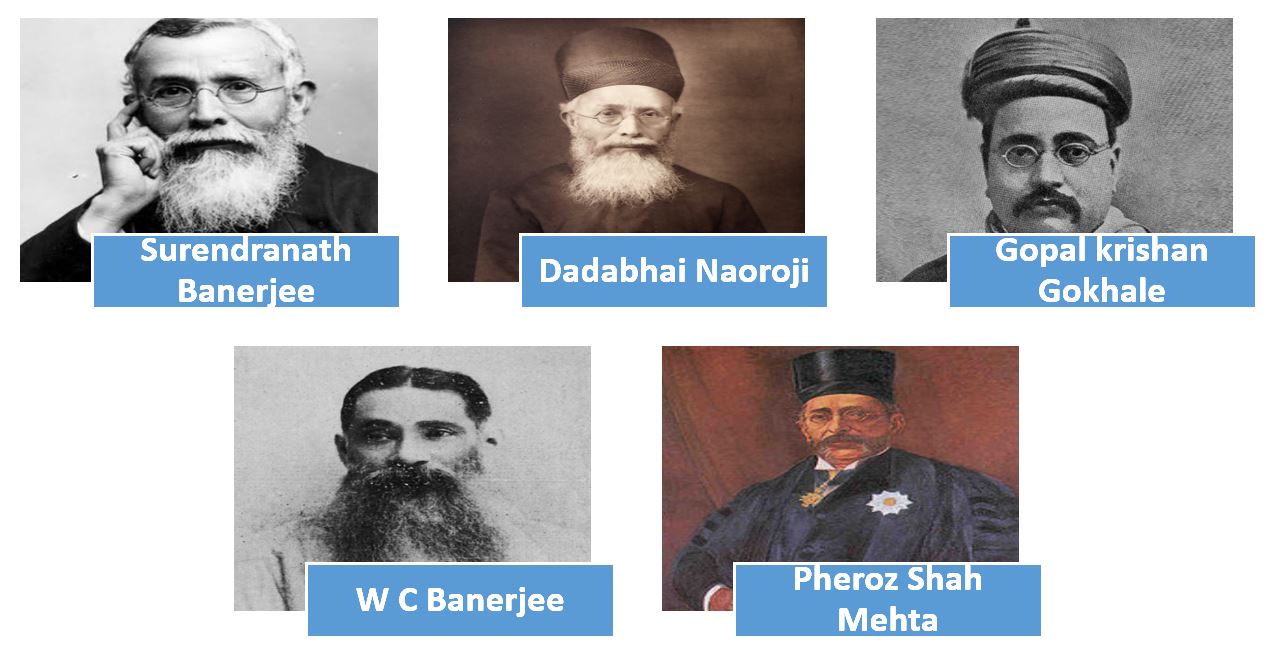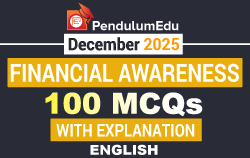Moderates and Extremists Phase of the Indian National Movement
There were ideological differences between the Moderates and Extremists. Both of these ideologies played a significant role in the Indian National movement. The key differences between the Moderates and Extremists were based on their ideologies against the British rule in India and their way of working.
Moderate Phase
- The phase between 1885–1905 is called the period of the moderates.
- The Moderates carried out constitutional agitation within the boundaries of law.
- They presented public demands to the Government by the means of petitions, resolutions, meetings, etc.
- They believed that British authorities would accept public demands slowly over a period of time.
Economic Critique by Moderates
- This was the most valuable contribution of moderates.
- Dadabhai Naoroji and others found that British rule was actually making the country poorer and eliminating its indigenous handcraft manufacturing.
- It was not bringing about the industrial revolution that the Indian elite had been expecting.
- Dadabhai Naoroji pointed out that the economic drain is the main cause of the impoverishment of India.
Demands of Moderates
- A larger voice for Indians in the government and in administration was advocated by moderates.
- It was the Legislative Council reforms that they demanded.
- They advocated for increased representation in Legislative Councils.
- Legislative Councils were to be given increased authority. They were to be established in provinces that did not already have them.
- They insisted on seeing more Indians in leadership roles inside the administration.
- The repeal of the Arms Act and the division of the judiciary and executive branches were among the other demands.
- The goal of the moderate leaders was to raise public awareness of how unfair British rule was.
| Moderate Leaders | |
| Dadabhai Naoroji | Pherozshah Mehta |
| E. Dinesh Wacha | W.C. Banerjee |
| Surendranath Banerjee | A.O. Hume |
| Badruddin Tayebji | M.G. Ranade |
| V.S. Shrinivas Shastri | C. Shankaran Naiyar |
| Tej Bahadur Sapru | Madan Mohan Malviya |
| Gopal Krishna Gokhale | Ras Bihari Ghosh |
| Anand Mohan Bose | Mohan Lal Ghosh |
| C.Y. Chintamani | P. Anand Charlu |
| K.T. Tailang | S. Subrahmanyam Aiyer |
| R.C. Dutt | Rahimtulla M. Sayani |
Important Moderate Leaders
Surendranath Banerjee
- In 1883, he brought people together for Indian National Conference at Kolkata.
- In 1886, he merged Indian National Conference with Indian National Congress.
Gopal Krishna Gokhale
- He is known as the Political Guru of Gandhi.
- He founded Servants of India Society in 1905.
- He became President of Indian National Congress in 1905.
Dadabhai Naoroji
- He is known as the Grand Old Man of India.
- He was elected as the president of Indian National Congress in 1886, 1893 and 1906.
- He authored “Poverty and UnBritish Rule in India” and founded the London Indian Society.
- He asked for Swaraj (self-rule) for the first time in 1904.
Extremist Phase
- In India’s national movement, the years 1905–1918 are referred to as the Era of Extremists.
- The Extremists advocated for self-rule or Swaraj in place of constitutional changes.
- The Extremists supported direct political action.
Criticisms of Moderates by Extremists
- The Moderates were criticized by the Extremists for failing to establish India's political objectives.
- They also criticized moderates for employing mild and ineffective tactics.
- Moderates were also criticized by Extremists for failing to turn the movement into a mass movement.
Reasons for the Rise of Extremists
- It was realized that British rule was exploitative in its true nature.
- The myth of European supremacy was demolished by international influences and events like victory of Ethiopia over Italy (1896) and victory of Japan over Russia (1905).
- There was dissatisfaction with the Moderates’ achievements.
- Lord Curzon’s reactionary policies like Calcutta Cooperation Act (1904) and Partition of Bengal (1905).
- A militant school of thought already existed and trained leadership had emerged.
| Extremist Leaders | |
| Bal Gangadhar Tilak | Lala Lajpat Rai |
| Bipin Chandra Pal | Aurobindo Ghosh |
| Chakravarthi Viji Raghvachariar | Raj Narayan Bose |
| Aswini Kumar Dutta | Chidambaram Pillai |
| T. Prakasham |
|
Important Extremist Leaders
Bal Gangadhar Tilak (Lokmanya Tilak)
- He launched Kesari and Maratha newspapers.
- Kesari was launched in Marathi and Maratha was launched in English.
- Ganpati Festival and Shivaji Festival were organised by Bal Gangadhar Tilak.
- Ganpati Festival was organised in 1893. Shivaji Festival was organised in 1895.
- He was sent to Mandlay Jail (Burma). In 1916, he began Home Rule League.
- He is the author of Gita Rahasya.
- The slogan “Swaraj is my Birthright and I will have it”, was given by Tilak.
- In Tilak’s words, Indian National Congress practiced politics of prayer, petition and protest and it was a begging institute.
- He was called Father of Indian Unrest by Sir Ignatius Valentine Chirol.
Lala Lajpat Rai
- He was from Punjab. He is also called Sher-e-Punjab.
- He laid the foundation of National School at Lahore.
- He succumbed to injuries after he was assaulted by the police during demonstration at Lahore against Simon Commission.
- In the words of Lala Lajpat Rai, congress conferences were annual national festivals of educated Indians.
- Italy’s Mazzini was his political guru.
Bipin Chandra Pal
- He launched New India, an English weekly.
- He also founded Banda Matram. It was an English weekly newspaper.
- He entered Brahmo Samaj.
- He is called the Father of Revolutionary Thoughts in India.
Sri Aurobindo Ghosh
- He started Jugantar (Yugantar), a Bengali daily.
- He faced trials in Manicktolla (Calcutta) Bomb Conspiracy Case, also called Alipore Bomb Case.
- He was nominated twice for the Nobel Prize. However, he was not awarded Nobel Prize.
- He authored “The Life Divine”, “Synthesis of Yoga” and “Savitri: A Legend and a Symbol”.
Difference between Moderates and Extremists
| S. No. | Points of Differentiation | Moderates | Extremists |
| 1. | Social base | Upper middle classes in towns and zamindars | Educated middle as well as lower middle classes in towns |
| 2. | Inspired by | European history and western liberal thought | Indian cultural heritage and history |
| 3. | Belief | They believed that political connections with Britain is in India’s interest. | They believed that political connections would increase India’s exploitation by Britain. |
| 4. | Loyalty to British crown | In favour of loyalty to British crown | Believed British crown does not deserve Indian loyalty |
| 5. | Scope of the movement | Believed in restricting the movement to middle class intelligentsia and masses are not ready to take part in political work | Believed in masses’ capacity to take part and make sacrifices |
| 6. | Demands | Demand for Constitutional reforms, Indians’ share in services | Demand for Self rule (Swaraj) |
| 7. | Methods | Only constitutional methods | Extra-constitutional methods, for example, boycott and passive resistance |
| 8. | Response to Montagu-Chelmsford Reforms | The Moderates welcomed these reforms.
| The Extremists rejected these reforms. |
| 9. | Swadeshi and Boycott movement after partition of Bengal | The moderates desired to limit the Boycott movement to Bengal and to boycott of foreign goods. | The extremists desired to spread the Boycott movement from Bengal to other parts of country and to all forms of association with British government. |






 Latest
Latest 



Comments